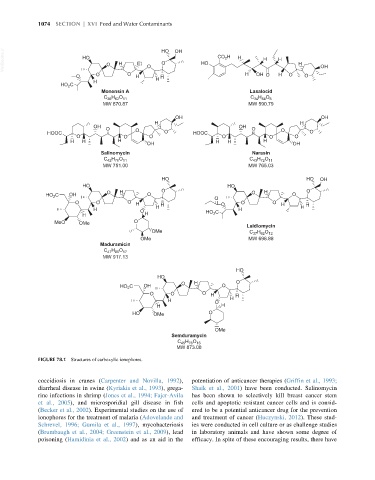Page 1142 - Veterinary Toxicology, Basic and Clinical Principles, 3rd Edition
P. 1142
1074 SECTION | XVI Feed and Water Contaminants
VetBooks.ir HO O H Et O HO OH HO CO H H H H H OH
2
O
O O O H H H OH O H O O
H H
HO 2 C
Monensin A Lasalocid
C H O 11 C H O 8
34 54
36 62
MW 670.87 MW 590.79
OH OH
H H
OH OH
O O O O
HOOC O HOOC O
O O O O O O
H H H H H H
OH OH
Salinomycin Narasin
C H O 11 C H O 11
42 70
43 72
MW 751.00 MW 765.03
HO HO OH
HO HO
HO 2 C OH O H O O O H O O
O
O O O H H O O O H H
H O H C H H
H H HO 2
MeO OMe O
Laidlomycin
OMe C H O 12
37 62
OMe MW 698.88
Maduramicin
H O
C 47 80 17
MW 917.13
HO
HO
O H O
C OH O
HO 2
O O O H H
H O H
H H
HO OMe O
OMe
Semduramycin
H O
C 45 76 16
MW 873.08
FIGURE 78.1 Structures of carboxylic ionophores.
coccidiosis in cranes (Carpenter and Novilla, 1992), potentiation of anticancer therapies (Griffin et al., 1993;
diarrheal disease in swine (Kyriakis et al., 1993), grega- Shaik et al., 2001) have been conducted. Salinomycin
rine infections in shrimp (Jones et al., 1994; Fajer-Avila has been shown to selectively kill breast cancer stem
et al., 2005), and microsporidial gill disease in fish cells and apoptotic resistant cancer cells and is consid-
(Becker et al., 2002). Experimental studies on the use of ered to be a potential anticancer drug for the prevention
ionophores for the treatment of malaria (Adovelande and and treatment of cancer (Huczynski, 2012). These stud-
Schrevel, 1996; Gumila et al., 1997), mycobacteriosis ies were conducted in cell culture or as challenge studies
(Brumbaugh et al., 2004; Greenstein et al., 2009), lead in laboratory animals and have shown some degree of
poisoning (Hamidinia et al., 2002) and as an aid in the efficacy. In spite of these encouraging results, there have

